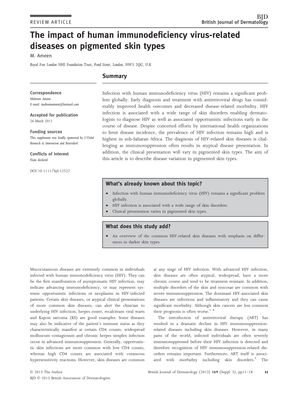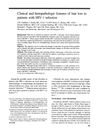The Impact of HIV-Related Diseases on Pigmented Skin Types
October 2013
in “
British Journal of Dermatology
”
HIV immunodeficiency skin disorders mucocutaneous diseases opportunistic infections CD4 counts antiretroviral therapy inflammatory skin diseases photosensitivity drug reactions Kaposi sarcoma non-AIDS-defining skin cancers hair disorders nail disorders ART skin diseases immune system skin infections immune cells HIV treatment skin inflammation sun sensitivity medication reactions Kaposi's sarcoma skin cancers hair problems nail problems

TLDR HIV can cause skin disorders, which are often the first sign of infection, especially in people with darker skin.
The 2013 article reviewed the impact of HIV on skin disorders, particularly in individuals with pigmented skin types. It noted that skin conditions can be the first sign of HIV infection or indicate advancing immunodeficiency. The prevalence of skin diseases is high in HIV-infected individuals, especially in sub-Saharan Africa, and these conditions often present atypically due to immunosuppression. Mucocutaneous diseases are common and can reflect the patient's immune status, with opportunistic infections being more prevalent at lower CD4 counts. The introduction of antiretroviral therapy has reduced the incidence of these skin diseases, but their recognition is still crucial for early HIV detection and treatment. The review also covered the epidemiology of HIV, clinical presentation of skin diseases in darker skin types, and the importance of recognizing these conditions. It mentioned that opportunistic infections, inflammatory skin diseases, photosensitivity, drug reactions, and malignancies like Kaposi sarcoma are affected by HIV, and that non-AIDS-defining skin cancers have increased with longer life expectancies due to ART. Hair and nail disorders are also common in HIV-infected patients.





